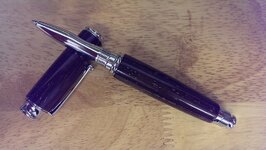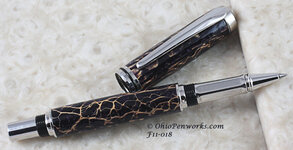Sandsini
Member
I have been lurking for a month or so while I accumulated the tools to become a Pen Turner... and today it all came together. I have my cheapie lathe, a cheapie band saw (I should stop saying cheapie, everything I bought is kind of cheapie, I'm working on a budget for now), chisels, blanks, kits... everything to start turning pens.
I decided to start with a Navigator Rollerball kit in Wenge. I drilled and turned it (thinking I did a pretty good job turning it for my first time ever on a lathe) and finished it in CA, and then redid the finish, and redid the finish, etc. until I have what you see here :frown:. As you can see there light indentations in the finish which I was never able to get beyond. I would sand it down and re-apply the CA but every time, it came out the same.
I called it a day after several hours and assembled the pen. Of course I pressed it all together without the thread insert that attaches the cap to the body of the pen. Ah well... Mark this one up to practice and onwards and upwards.
Does anyone have a hint on how to avoid the finish problem? I really liked using the CA other than that.
Eric
I decided to start with a Navigator Rollerball kit in Wenge. I drilled and turned it (thinking I did a pretty good job turning it for my first time ever on a lathe) and finished it in CA, and then redid the finish, and redid the finish, etc. until I have what you see here :frown:. As you can see there light indentations in the finish which I was never able to get beyond. I would sand it down and re-apply the CA but every time, it came out the same.
I called it a day after several hours and assembled the pen. Of course I pressed it all together without the thread insert that attaches the cap to the body of the pen. Ah well... Mark this one up to practice and onwards and upwards.
Does anyone have a hint on how to avoid the finish problem? I really liked using the CA other than that.
Eric


